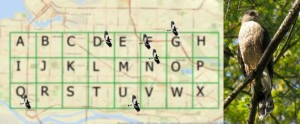Urban Raptor Monitoring
Urban areas are not ideal habit for most birds, but some species seem to make it work. Species such as the European starling (Sturnus vulgaris) and house sparrow (Passer domesticus) are abundant in developed environments. Some birds of prey also adapted to urban environments, such as peregrine falcons (Falco peregrinus), often taking advantage of man-made structures for nests, and the Cooper’s hawk (Accipiter cooperii), taking advantage of the abundant prey.
Top predators, such as birds of prey, are effective sentinels for environmental health. In urban environments , these top predators have additional factors that can impact their success and abundance. Anthropogenic factors such as vehicular collisions, window strikes, and environmental pollutants compound the effects of environmental factors, such as prey abundance and habitat availability.
There has been many studies demonstrating the effectiveness of raptors as monitors of environmental health. The peregrine falcon, as well as many other birds of prey, witnessed huge population declines due to enviroinemtnal pollutants, specifically DDE (a metabolite of DDT). And long term studies in the United Kingdom have found declines in sparrowhawks (Accipter nisus) due to pesticide exposure.
Cooper’s hawks provide a good model to examine exposure to, and the effects of contaminants on urban wildlife because they have successfully adapted to the urban environment and can routinely be found in greater densities in urban areas than in adjacent rural or forested areas; they are resilient to human intrusions and rarely abandon their nests if disturbed; they exhibit high nest fidelity allowing for multiple observations over time.
WildResearch is conducting Cooper’s hawk surveys across the lower mainland of British Columbia to estimate their population abundance. Their abundance is reflective of the surrounding environmental health. The goal is to use the Cooper’s hawk abundance as a reflection of the surrounding environmental health. Habitat variables will be collected and periodically funds will be obtained to sample the hawks for exposure to environmental pollutants. The data collected will be able to inform land management decisions and aid in the understanding of pollutants and their effect on wildlife.
To participate in WildResearch Urban Raptor Monitoring, please contact info@wildresearch.ca.
